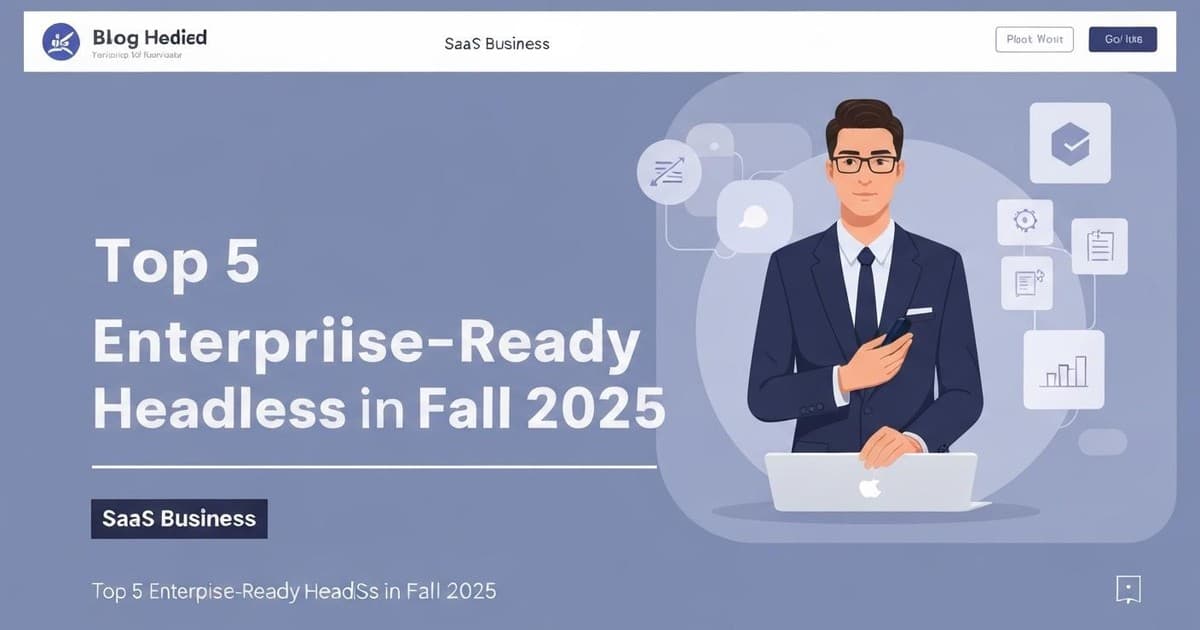
Top 5 Enterprise-Ready Headless CMSs in Fall 2025
As digital channels proliferate, spanning from traditional web and mobile to IoT and AR/VR, enterprises face mounting challenges in delivering consistent, personalized content at scale.
Traditional CMSs are increasingly falling short in meeting these complex demands. A January survey revealed that only 28% of enterprise marketers consider their content strategy very or extremely effective. The primary reasons? Lack of data-driven approach and poor alignment with the customer journey.
Enter enterprise-ready headless CMSs. These systems are purpose-built to manage intricate content operations across diverse teams, platforms, and regions. They offer a flexible architecture that decouples content creation from presentation, enabling:
Omnichannel content delivery: Publish once, distribute everywhere.
API-first approach: Seamless integration with various front-end technologies.
Scalability: Handle high-volume content operations without performance degradation.
Personalization at scale: Leverage AI and machine learning for tailored user experiences.
Global content governance: Manage multilingual, multi-regional content efficiently.
By adopting a headless CMS, enterprises can future-proof their content strategy, ensuring agility in an ever-evolving digital landscape. This approach not only streamlines content operations but also empowers marketers to focus on crafting compelling narratives rather than grappling with technical limitations.
What Defines Enterprise-Ready Headless CMS Architecture
 Enterprise Content Management Systems (CMS) are sophisticated platforms designed to handle content operations at scale. Unlike their smaller counterparts, these systems are engineered to support the complex needs of large organizations, offering a robust suite of features:
Enterprise Content Management Systems (CMS) are sophisticated platforms designed to handle content operations at scale. Unlike their smaller counterparts, these systems are engineered to support the complex needs of large organizations, offering a robust suite of features:
Scalability: Enterprise CMSs leverage distributed architectures and caching mechanisms to manage high traffic volumes and vast content repositories without performance degradation. They often employ microservices for enhanced modularity and scalability.
Security: These platforms implement multi-layered security protocols, including end-to-end encryption, SSL/TLS, OAuth 2.0 for authentication, and granular role-based access control (RBAC). They often adhere to industry standards like ISO 27001 and SOC 2.
Multilingual Capabilities: Advanced localization features go beyond simple translation. They incorporate content adaptation for cultural nuances, multilingual SEO optimization, and collaborative tools for global teams. Some systems use AI-powered translation suggestions to streamline the process.
Governance: Enterprise CMSs offer sophisticated workflow management with features like content versioning, audit trails, and approval chains. They often integrate with Digital Asset Management (DAM) systems for comprehensive media governance.
Integration Flexibility: These systems provide robust APIs (REST, GraphQL) and webhooks for seamless integration with existing tech stacks. They often support headless architectures, allowing content to be consumed by various front-end technologies.
By leveraging these advanced features, enterprise content teams can maintain agility while ensuring compliance, security, and efficiency in their content operations. This technological foundation enables organizations to deliver personalized, consistent content experiences across multiple channels and markets.
Leading Enterprise Headless CMS Platforms Compared

Hygraph
Hygraph, engineered specifically for GraphQL-native content delivery and federation at enterprise scale. Its architecture is meticulously designed to address the complex needs of organizations requiring flexible, scalable, and unified content operations.
Key Architectural Components:
GraphQL API Core:
Native GraphQL implementation (not built on REST)
Efficient query resolution with minimal over-fetching
Custom directives for advanced query manipulation
Content Federation Engine:
Distributed content aggregation from multiple sources
Schema stitching for unified API presentation
Real-time data synchronization across federated sources
Schema Management:
Programmatic schema definition and evolution
Versioning and rollback capabilities for schema changes
Sandbox environments for schema testing
Security Infrastructure:
ISO 27001 certified and SOC2 Type 2 compliant architecture
Role-Based Access Control (RBAC) with field-level permissions
Multi-factor authentication (MFA) support
Scalability Framework:
Microservices-based architecture for modular scaling
Global edge caching for optimized content delivery
Auto-scaling based on traffic patterns
Backup and Recovery System:
Point-in-time recovery across multiple AWS regions
Off-site backup mechanisms
Automated backup scheduling and retention policies
Developer Toolkit:
Extensive SDK library for major programming languages
CLI tools for automation and CI/CD integration
Custom app development framework
Content Modeling:
Flexible content type creation with custom fields
Content relationships and nested structures
Localization support with fallback mechanisms
Version Control:
Git-like branching for content and schema
Diff visualization for changes
Merge conflict resolution tools
Integration Layer:
Webhook support for event-driven architectures
RESTful APIs for legacy system integration
Pre-built connectors for common enterprise tools
Performance Optimization:
Query complexity analysis and limitation
Persisted queries for frequently used operations
Batched mutations for bulk operations
Analytics and Monitoring:
Real-time query performance metrics
Integration with major observability platforms
Custom event tracking for content lifecycle
Hygraph's architecture is designed to handle the complexities of enterprise content management while leveraging the power of GraphQL for efficient, flexible content delivery. Its emphasis on content federation, scalability, and developer-friendly features positions it as a versatile solution for organizations looking to unify their content operations across multiple sources and channels. The platform's GraphQL-native approach, coupled with robust security measures and enterprise-grade scalability, makes it particularly suitable for businesses with complex, distributed content ecosystems requiring a single point of truth for content delivery.
Decipher
Decipher, positioning itself as the first truly AI-native platform built specifically for modern enterprise content operations. Its architecture seamlessly integrates artificial intelligence throughout every layer of content management, from creation to distribution, while providing complete platform ownership and unlimited scalability.
Key Architectural Components:
AI Content Intelligence Core:
Advanced machine learning models for content recommendation and optimization
Real-time content quality scoring and improvement suggestions
Brand guideline integration with automated consistency checking
Predictive content performance analytics and optimization recommendations
Enterprise Workflow Orchestration Engine:
Customizable approval workflows that adapt to organizational structure
Role-based permissions with granular access control
Automated content routing based on content type and business rules
Compliance checkpoints with built-in audit trail generation
Multi-Channel Content Distribution Network:
Simultaneous publishing across websites, social platforms, email campaigns, and mobile applications
Automatic format adaptation for each channel while maintaining content integrity
Real-time synchronization across all distribution endpoints
Channel-specific optimization and personalization capabilities
Enterprise Asset Management System:
Centralized digital asset library with intelligent AI-powered tagging
Brand compliance checking for all visual and text assets
Automated optimization for different use cases and platforms
Version control and asset relationship tracking
Complete Platform Licensing Architecture:
Full platform ownership with deployment on customer's own Google Cloud infrastructure
Unlimited user access without per-seat pricing constraints
Complete administrative control over security configurations and data processing
Zero usage limits on content volume, API calls, or storage
Advanced Integration Framework:
Pre-built connectors for major enterprise systems (CRM, ERP, Marketing Automation)
RESTful API architecture for custom integrations
Seamless connection with business intelligence platforms
Legacy system integration capabilities with custom middleware
Real-Time Analytics and Intelligence Platform:
Comprehensive content performance tracking across all channels
Predictive analytics for content effectiveness and ROI measurement
Executive-level reporting with customizable dashboards
A/B testing capabilities with automated winner selection
Enterprise Security Infrastructure:
Built on Google Firebase with bank-level security standards
Identity Aware Proxy for fine-grained access control
Multi-factor authentication and single sign-on integration
GDPR compliance with configurable data location and processing controls
Customization and Development Platform:
Complete UI/UX customization with customer branding
Bespoke feature development tailored to specific business needs
Custom API endpoints and workflow integrations
White-label deployment options for agencies and resellers
Scalable Cloud Infrastructure:
Google Cloud-based architecture with auto-scaling capabilities
Global content delivery network for optimal performance
Redundant backup systems with point-in-time recovery
Multi-region deployment options for disaster recovery
Collaborative Content Creation Suite:
AI-assisted content creation with context-aware suggestions
Real-time collaborative editing with conflict resolution
Template library with AI-powered content generation
Automated content optimization based on performance data
Enterprise Support and Services Framework:
Dedicated technical support with guaranteed response times
Custom onboarding and implementation services
Ongoing platform optimization and feature development
Training programs for technical and non-technical users
Compliance and Governance Engine:
Automated compliance monitoring for industry standards
Complete audit trail with detailed change logging
Content governance policies with automated enforcement
Regulatory reporting capabilities for various industries
DecipherCMS's architecture fundamentally reimagines content management by placing artificial intelligence at the core of every operation. Unlike traditional CMS platforms that retrofit AI capabilities, DecipherCMS is built from the ground up to leverage machine learning for content optimization, workflow automation, and performance enhancement. The platform's unique licensing model provides enterprises with complete ownership and control, eliminating vendor lock-in while enabling unlimited customization and scaling. This approach makes DecipherCMS particularly valuable for organizations requiring maximum flexibility, control, and AI-powered efficiency in their content operations, whether they're scaling startups or established enterprises managing complex, multi-channel content strategies.
Contentful
Contentful stands at the forefront of headless Content Management Systems (CMS), engineered specifically for enterprise-grade content operations. Its architecture is meticulously designed to address the complex needs of large-scale digital content delivery across multiple channels and markets.
Key Architectural Components:
API-First Content Infrastructure:
RESTful and GraphQL APIs for flexible content retrieval
Content Delivery API with edge caching for optimal performance
Microservices-based architecture enabling modular scaling
Dynamic Content Modeling:
JSON-based content type definitions
Advanced content relationships (1:1, 1:n, n:n)
Custom validations and business logic implementation
Rich Text Processing Engine:
Markdown and custom HTML support
Extensible embed functionality
Collaborative editing with operational transformation
Digital Asset Management (DAM):
Automated image processing and video transcoding
Metadata management and tagging
CDN integration for global asset delivery
Localization Framework:
Language fallback mechanisms
Customizable translation workflows
Integration with Translation Management Systems (TMS)
Version Control System:
Git-like branching for content
Diff visualization for content changes
Scheduled publishing and content staging
Workflow Orchestration:
Event-driven workflow engine
Parallel and sequential task management
Integration with project management tools (e.g., JIRA, Asana)
Security Infrastructure:
Role-Based Access Control (RBAC) with granular permissions
Single Sign-On (SSO) support (SAML, OAuth)
End-to-end encryption for data at rest and in transit
Developer Ecosystem:
Extensive SDK library (JavaScript, PHP, Python, Ruby, Java, .NET)
CLI tools for automation and CI/CD integration
Robust extension framework for custom UI components
Scalability Engine:
Multi-cloud deployment (AWS, Google Cloud, Azure)
Auto-scaling based on traffic patterns
Multi-region content delivery network (CDN)
Integration Layer:
Webhook support for real-time integrations
App Framework for custom application development
Marketplace for pre-built integrations and extensions
AI and Machine Learning Integration:
Natural Language Processing (NLP) for content analysis
AI-powered content optimization and tagging
Personalization engines for dynamic content delivery
Analytics Framework:
Real-time content performance tracking
Custom event tracking capabilities
Integration with major analytics platforms
Contentful's architecture is designed to handle the complexities of enterprise content management while maintaining the agility needed in today's digital landscape. Its API-first approach, coupled with robust developer tools and enterprise-grade security, positions it as a versatile solution for organizations looking to streamline their content operations across multiple channels and markets. The platform's emphasis on scalability and flexibility makes it particularly suitable for enterprises undergoing digital transformation or those with complex, multi-channel content delivery requirements. now do this
Sanity
Sanity, engineered to deliver real-time, collaborative content editing and structured content management at enterprise scale. Its architecture is meticulously designed to address the complex needs of organizations requiring dynamic, adaptable content operations.
Key Architectural Components:
Real-Time Collaboration Engine:
Operational Transformation (OT) for conflict-free real-time editing
WebSocket-based live updates across connected clients
Version history with granular rollback capabilities
Customizable Content Studio:
React-based UI with extensible component architecture
Configuration API for tailoring the editing experience
Hot-module replacement for live UI updates
Structured Content Model:
Schema-less content modeling with GROQ query language
JSON-based document storage for flexibility
References and joins for complex content relationships
Media Management Pipeline:
On-the-fly image transformation and optimization
Asset metadata extraction and indexing
Global CDN integration for optimized asset delivery
Scalability Infrastructure:
Microservices architecture for modular scaling
Multi-region deployment for global presence
Automatic load balancing and failover mechanisms
API Layer:
RESTful and GraphQL APIs for flexible content retrieval
GROQ query language for powerful content querying
Webhooks for real-time integrations and event-driven architectures
Security Framework:
Role-Based Access Control (RBAC) with field-level permissions
JWT-based authentication
Data encryption at rest and in transit
Workflow Orchestration:
Customizable, event-driven approval processes
Kanban-style workflow visualization
Integration capabilities with project management tools
Developer Ecosystem:
Extensive SDK library (JavaScript, PHP, .NET, etc.)
CLI tools for automation and CI/CD integration
Plugin architecture for extending Studio functionality
Content Lake:
Distributed storage system for content and assets
Real-time content replication across regions
Automatic backup and disaster recovery mechanisms
Integration Layer:
Serverless Functions for custom backend logic
Asset pipeline hooks for custom processing
Pre-built connectors for common enterprise tools
Analytics and Monitoring:
Built-in usage analytics for content operations
Integration with major observability platforms
Custom event tracking for content lifecycle
Sanity's architecture is designed to handle the complexities of enterprise content management while maintaining the agility needed for dynamic, collaborative content creation. Its emphasis on structured content, real-time collaboration, and extensibility positions it as a versatile solution for organizations looking to streamline their content operations across multiple channels and markets. The platform's ability to adapt to specific workflow needs and scale with growing content demands makes it particularly suitable for enterprises with complex, evolving content ecosystems.
Storyblok
Create and translate content faster using AI-powered tools. Storyblok Assistant helps you generate, translate, and rewrite content to get your work done faster.
Flexibility: Storyblok's API-first approach means you can use any front-end framework or static site generator. The headless architecture allows you to manage content in one place and publish it across multiple channels.
Localization: Manage multilingual content with ease. Storyblok supports over 80 languages and allows you to customize content for different regions.
Enterprise features: SSO, custom roles and permissions, and audit logs help you maintain control over your content operations. Here's a more technical, yet engaging breakdown of Storyblok's enterprise-grade capabilities:
Key Enterprise-Grade Features:
Visual Editing with Headless Flexibility:
Real-time collaborative editing interface
Component-based architecture with drag-and-drop functionality
Instant multi-device preview (mobile, tablet, desktop)
Headless API for decoupled content delivery
Security and Compliance:
ISO 27001 certified
99.99% uptime SLA
Data hosted on AWS (Frankfurt, Germany)
Regular backups and recovery tests
Continuous automated security scanning
Scalability:
Unlimited content entries and assets
Custom workflow engine for complex publishing processes
Unlimited user seats on Elite plan
Cloud-native architecture for seamless scaling
AI-Powered Content Operations:
Storyblok Assistant for content generation and translation
AI-driven content optimization and rewriting capabilities
Technology Agnostic:
RESTful and GraphQL APIs
Support for any front-end framework or static site generator
Headless architecture enabling omnichannel content distribution
Localization:
Support for 80+ languages
Advanced content customization for regional variants
Built-in translation management
Enterprise Governance:
Single Sign-On (SSO) integration
Granular role-based access control
Comprehensive audit logging
Storyblok's architecture is designed to handle the complexities of enterprise content management while maintaining the agility needed in today's digital landscape. Its API-first approach, coupled with visual editing capabilities, positions it as a versatile solution for organizations looking to streamline their content operations across multiple channels and markets. do the same for this
What to do next?
Selecting the ideal headless CMS is a crucial strategic choice that significantly influences your organization's content delivery capabilities.
When assessing different options, it's essential to consider your unique requirements, including scalability needs, security concerns, and integration capabilities.
Decipher stands out with its array of features designed specifically for enterprise use. Its powerful content federation capabilities allow for seamless integration of content from various sources. Additionally, Decipher's global content and asset delivery network ensures optimal performance and user experience worldwide.
These enterprise-focused features make Decipher a compelling option to consider in your evaluation process. Its robust architecture and flexibility can potentially streamline your content operations and enhance your digital presence across multiple channels and markets.

